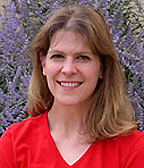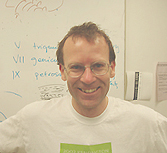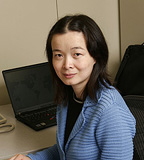
| T H E N I H C A T A L Y S T | M A R C H – A P R I L 2007 |
|
|
|
ON TRACK |
|
 |
|
Catharine
Bosio
|
With this issue of The NIH Catalyst, we launch a new feature profiling the work of NIH intramural researchers newly arrived to the tenure track.
Catharine Bosio has joined NIAID’s Laboratory of Intracellular Parasites at the Rocky Mountain Laboratories in Hamilton, Mont., where she will study the pulmonary pathogen Francisella tularensis, a continuation of the research she conducted slightly lower down on the mountain chain when she was an assistant professor at Colorado State University in Fort Collins.
Although rare, this bacterium produces flu-like symptoms with a 60–80 percent mortality rate. It can be ingested, inhaled, or absorbed through the skin. Tularemia infections are seen in such diverse groups as landscapers on Martha’s Vineyard and hunters in the Western states.
Bosio’s goals are twofold: to identify better treatment options (currently either streptomycin or gentamicin) and also to use this virulent bacterium as a model to study pulmonary infections.
She and her colleagues have found that F. tularensis infection elicits production of TGF-b, a potent immunosuppressive cytokine. And F. tularensis actively suppresses the ability of dendritic cells to alert the host to the invading pathogen.
The big picture, she says, is that F. tularensis may not be unique among pathogens in its ability to "selectively uncouple antigen-presenting functions from proinflammatory cytokine secretion by critical antigen-presenting cells in the lungs, which may serve to create a relatively immunosuppressive environment favorable to replication and dissemination of the organism."
Bosio has also worked on Ebola and Marburg viruses and pneumonic plague.
 |
|
Mark
Hoon
|
Mark Hoon of NIDCR came to NIH in the early 1990s as a postdoc and had considerable success in Nick Ryba’s lab in the Taste and Smell Unit in identifying taste receptors. Now in the Laboratory of Sensory Biology, he is getting a feel for somatosensory research.
Surprisingly little is known, he says, about how we sense pain, temperature, the position of our arms, or the nature of an object by touch. Hoon hopes to do the same for the sense of touch that he and his colleagues have done for taste.
Key to this effort is identifying the receptors for touch, found in specialized neural endings just below the skin. The cells have been characterized, and different classes of neurons—such as fast- and slow-adapting—have been identified.
Humans have millions of sensory receptors, concentrated in the fingertips, lips, and tongue. Just as human taste buds are selective for different tastes (such as bitter or sweet), so, too, are touch receptors primed for different "flavors" of touch, such as vibration or pressure. Sensory information is carried from these touch receptors to the sensory cortex in the brain. Current knowledge of just how this transmission is accomplished is relatively crude, Hoon observes.
Using a mouse model, he plans to start to map the touch neural pathway "from the molecule up."
He will conduct a systematic search for the receptor and signaling molecules in mice using a variety of molecular screening techniques. In mice, he notes, it is the whiskers that are most sensitive to touch.
 |
|
Xiaoling
Li
|
Xiaoling Li, leader of the mammalian aging group in the Laboratory of Signal Transduction at NIEHS, hopes to bring the exciting research on aging and Sir2 to the next level—that is, the mouse.
Sir2 is the famed protein found to extend the lifespan of yeast, worms, and fruit flies; it seems to be activated through caloric restriction.
Li’s research, a continuation of her recent postdoc work at MIT, focuses on the NAD+-dependent protein deacetylase Sir2 and corresponding post-translational modification of nuclear receptors in aging and age-associated diseases.
The problem with mice, however, is that they don’t age as quickly as yeast and flies, and it is therefore more difficult to study aging effects. Li’s approach is to use the onset of age-related disease, such as cardiovascular disease, as a marker for aging. These changes, albeit slight, can be detected month by month.
Her group has so far shown that SIRT1, the mammalian orthologue of Sir2, removes an acetyl group from liver X receptors, members of a nuclear receptor superfamily, and regulates their transcriptional activity and corresponding cholesterol homeostasis.